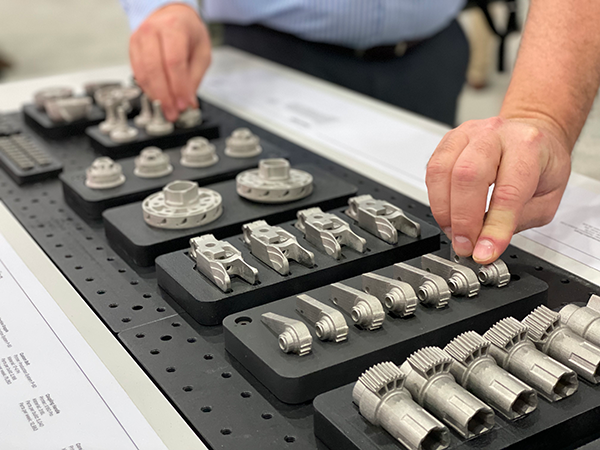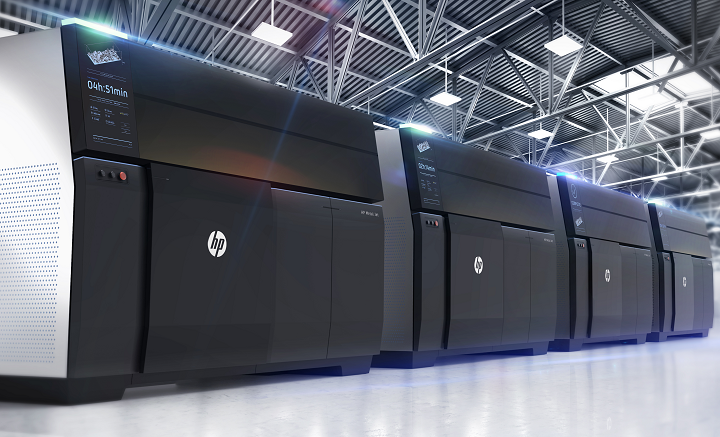Apple Inc. (Nasdaq: AAPL), the Cupertino-based tech behemoth, is once again set to revolutionize an industry, this time targeting manufacturing. According to a recent Bloomberg report, the company is testing the use of binder jet 3D printers to produce the steel chassis of its future smartwatches. While its use of the technology is still nascent and largely experimental, its successful implementation could significantly alter how Apple and perhaps even the entire tech industry approach manufacturing.
While Apple is known for its secrecy, it is an open secret that the tech giant uses additive manufacturing (AM) in-house. Most of this use is said to be for the traditional applications: prototyping, tooling, and R&D. Additionally, there have been numerous rumors throughout the years related to patents the company has filed. I have personally speculated that it may be relying on electronics 3D printing to streamline its product designs.
 A BLT metal 3D printing factory.
A BLT metal 3D printing factory.The Bloomberg story adds weight to the possibility that Apple has turned to AM for actual end part production, citing unnamed “people with knowledge of the matter.” This possibility was first raised last month, when financial analyst Ming-Chi Kuo reported that Apple would be using laser powder bed fusion (LPBF) to 3D print titanium parts for the Apple Watch Ultra.
This latest story builds out the smartwatch with further smart manufacturing technology. In this case, Bloomberg states Apple is exploring metal binder jetting to 3D print the steel chassis for its smartwatches. This is a crucial detail given the state of the market right now, as polymer 3D printing stalwart Stratasys (Nasdaq: SSYS) is in talks to merge with binder jet firm Desktop Metal (NYSE: DM), potentially forcing a competitor to acquire fellow binder jetting company Markforged (NYSE: MKFG). This raises an important question: whose binder jet technology is Apple using?
 Binder jet metal parts made by Desktop Metal. Image courtesy of Desktop Metal.
Binder jet metal parts made by Desktop Metal. Image courtesy of Desktop Metal.It could very well be systems from Desktop Metal or Markforged. GE’s large-scale binder jetting would seem too large for the production of watches but could offer the throughput needed for mass manufacturing. There’s also EasyMFG in China, which just released its latest binder jetting system. Given the relationship between Apple (and most companies) with manufacturers in Asia, it might make sense for the electronics conglomerate to find a connection there. After all, the LPBF equipment Ming-Chi Kuo claimed Apple would be using would come from Chinese companies Farsoon and Bright Laser Technologies.
3DPrint.com Macro Analyst Matt Kremenetsky provided a key detail that could clue us into whose binder jet technology Apple might be relying on:
Given that Berkshire Hathaway has a significant investment stake in Apple and is HP’s largest shareholder, there’s a possibility that the tech leader is using the Metal Jet S100 binder jetting platform in its exploration. Though HP quickly dominated the 3D printing market for polymers with its Multi Jet Fusion, the larger organization has yet to demonstrate profitability in its 3D printing divisions. A large client in Apple could change that for HP.
 HP MetalJet for mass production.
HP MetalJet for mass production.Regardless of who the company ultimately uses for manufacturing, Apple’s reliance on 3D printing for end part production would represent a paradigm shift for AM. The company is more than the world’s most profitable business. It is a synecdoche for success in design, marketing, and manufacturing. Therefore, a fully-fledged buy-in for 3D printing would transfer that aura to the AM sector, providing it the needed manufacturing cred to boost it forward.
Such a boost would be a serendipitous one, as nations and businesses globally are now throwing their weight behind the technology both as a means of sustainable production and supply chain insurance. By 3D printing components locally, it is possible to both cut emissions associated with shipping (among other environmental benefits) and avoid major disruptions associated with a globalized supply chain.
At the moment, the 3D printing industry is estimated to be worth some $13.5 billion by Additive Manufacturing Research group SmarTech Analysis. However, the huge amount of government traction the sector has gotten in the past several years has it growing at a rapid pace of 25 percent. In China alone, the compound annual growth is estimated to be roughly 30 percent. If tech giants like Apple come out publicly proclaiming their use of AM, we can expect that percentage to increase even further.
Subscribe to Our Email Newsletter
Stay up-to-date on all the latest news from the 3D printing industry and receive information and offers from third party vendors.
You May Also Like
New Report: Semiconductor Industry to See $1.4B in 3D Printing Revenues by 2032
“The semiconductor sector has become the most strategically significant area of global industry.” Truer words are hard to come by when it comes to the modern world, and they are...
Will Photonic-Crystal Lasers Revolutionize 3D Printing?
Powder bed fusion (PBF) for metals and polymers predominantly utilizes lasers as the primary heat source. Some directed energy deposition (DED) technologies also employ lasers, while various vat polymerization methods...
3D Printing Unpeeled: Orbex Investment, IndoMIM and HP, Ultrasonic Waves
INDO-MIM has bought three HP Metal Jet S100 printers, operating two in India and one in Texas. This is a win for HP because the company has deep experience in...
3D Printing Webinar and Event Roundup: April 21, 2024
It’s another busy week of webinars and events, starting with Hannover Messe in Germany and continuing with Metalcasting Congress, Chinaplas, TechBlick’s Innovation Festival, and more. Stratasys continues its advanced training...































